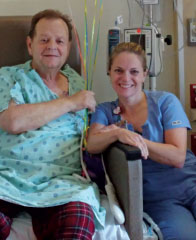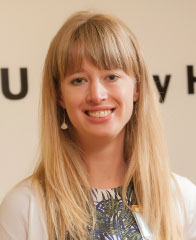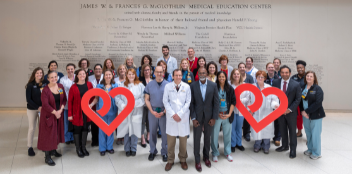Taking It to Heart
Celebrating the more than 250 nurses who brighten our patients’ lives.

The tin man from Oz. Inspirational words on a scroll. A big cat with a colorful, swirling mane entitled “Spirit of the Lion Heart.”
When visitors walk down the hallways of the Cardiothoracic Surgery Progressive Unit, they are surprised by the colorful pictures on the ceiling; all were created by patients or their families.
“The ceiling tiles are stories that patients tell, that we encourage them to express. Each of those tiles has a story—in some cases, it’s a message of encouragement for other patients,” says Clinical Nurse Specialist/Nurse Clinician Kim Nelson, DNP, RN-BC, ACNS-BC, who leads the nursing unit along with Nurse Manager Kelly Carter, MS, RN, NE-BC.
While some of their patients may stay just one night, perhaps following a procedure, “some patients waiting for transplants may be here weeks or months; a few may be here a year or more,” she says. “So you have to look at patients’ needs—not only their physical needs but their emotional and spiritual needs as well.”
In addition to the colorful tiles, the unit—composed of Main 10 West and 10 Central—is distinctive for its technology, including “Big Blues,” the 400+-pound compressors that keep things pumping for artificial heart patients not yet ready to return home with a backpack Freedom driver. Nurses on the unit have special training in caring for patients on mechanical circulatory support and ongoing education to stay current with the latest technology. They are also supported and encouraged to obtain nursing board certification in Progressive Care, Heart Failure, or Cardiovascular Nursing.
“We’re geeks for heart failure,” says Nelson, with a laugh. Her interest in the complex condition began in nursing school, when she cared for her grandmother.
The nurses work with interdisciplinary teams to provide holistic care. The transplant/device team, for instance, includes nurses as well as surgeons, cardiologists, heart failure specialists, social workers, physical and occupational therapists, chaplains, psychologists, a dietician, and care coordinators. Art and music therapists also offer support. In January 2011, the Hopeful Hearts Support Group was formed for patients and families who are in the hospital with a mechanical circulatory support device or heart transplant. Activities vary from creating tie-dye shirts to family-style meals. Sharing experiences that are life changing with each other along with the struggles that go along with them provides a special bond in the group.
 Kim Nelson and David Palumbo
Kim Nelson and David Palumbo
Sometimes, it’s the things that remind patients of home that matter most. Nurse Practitioner Morgan Childress, MSN, NP, brings in her boxer/hound mix as a volunteer for the “Dogs on Call” program. Often, details are worked out for patients to bring in their own pets for a visit.
“I cannot say enough great things about our nurses in the Pauley Heart Center,” says Anthony Cassano, MD, interim chair, Division of Cardiothoracic Surgery. “They are very compassionate and always have the patients’ best interest at heart.”
She adds, “We can fix your heart, but if we can’t keep your head and mind in the game, it won’t matter what we do. That’s what these nurses do and they’re brilliant at it.”
The 10 Central and 10 West teams were recognized with a DAISY Team award for arranging a candlelight dinner for a gravely ill artificial heart patient and her husband on Valentine’s Day. “One of the nurses, Lucy Alburger, RN, even brought in her grandmother’s china for them to have that special dinner,” recalls Nelson. (See sidebar for more information on these awards.)
“Sometimes I can’t believe what nurses accommodate here. It’s really the kindness that I’m very proud of,” says Director of Nursing Kathryn Perkinson, MSN, RN, CEN. “We have weddings up here, birthday parties. People get ready for prom here.”
She adds, “We can fix your heart, but if we can’t keep your head and mind in the game, it won’t matter what we do. That’s what these nurses do and they’re brilliant at it.”
It’s only 1 p.m., but Coronary Intensive Care Unit Nurse Practitioner Charlotte “Cha” Roberts, RN, MSN, has just returned from the emergency room, where she assessed her second cardiac arrest patient of the day.
Additionally, she’s participated in rounds, reviewed patient data, and managed transfers from other hospitals.
“A lot of what I do is process-oriented: making sure that we do the right things at the right time, expediently, and making certain that there are not any obstacles to care. Also making sure that our care is consistent and reflects adherence to guidelines,” she says.
 Sarah Paciulli, MS, RN, NP-C
Sarah Paciulli, MS, RN, NP-C
Roberts, who’s been in the nursing profession for 35 years, made a decision in 1995 to return to graduate school and become a nurse practitioner. “I am lucky to work with an amazing team of nurses and providers, especially in the Pauley Heart Center and the Emergency
Department,” she says.
Roberts is one of 20 Advanced Practice Providers—known as APPs—in the Division of Cardiology who provide bedside care to patients while also offering expertise in operations.
“The APPs come from all different types of backgrounds but share a very high level of sophisticated training in cardiology,” says Kenneth Ellenbogen, MD, the division’s chair.
Roberts’ patients in the 14-bed CICU include heart attack and cardiac arrest survivors, patients in cardiogenic shock or suffering complex ventricular arrhythmias, and those awaiting advanced heart failure therapies.
“Cha epitomizes what we strive for in the Pauley Heart Center, as she provides outstanding and compassionate care to patients as well as giving support to the families of patients who are frequently critically ill,” says CICU Director Michael Kontos, MD.
With today’s lifesaving technologies, “the patient population has certainly become more complex,” says Roberts. Additionally, “we have so much more data to review. You can’t make a plan this morning and expect it to be durable throughout the day. You’ve got to be looking at the patient constantly and reassessing their response to the therapies that you may have changed. It’s very dynamic.”
“Let me take a look at your pills,” says Cardiology Nurse Practitioner Sarah Paciulli, MS, RN, NP-C, to a patient during an office visit.
The middle-aged man, recently discharged from the Pauley Heart Center, dumps out the contents of a black plastic shopping bag. About 12 medicine bottles tumble onto her desk. As he sits nearby, she goes through the bottles one by one with him, entering the data into her laptop. Some of the bottles are empty; others are old, having been replaced by newer prescriptions.
The patient seems confused, admitting that it’s difficult to keep up with the prescriptions when they’re filled at different times of the month.
“I wonder if we could get you on a schedule with them all synched up at the same time,” says Paciulli. She makes arrangements to do just that with a pharmacy, which will also deliver the medications to the patient’s home.
Making care easier for patients is one of the goals of the Cardiology Navigator Team, whose members offer a four-week program aimed at educating heart failure and heart attack patients following their discharge from the hospital.
“Our clinic is a bridge from the hospital to the long term,” says Paciulli, who helped start the program—one of the first of its kind in the country—in February 2015. The team also includes nurse navigators Corey Reed and Amy Patton, pharmacist Patricia Uber, social worker Megan Maltby, and dietician Nicholas Fischetti.
“Patients and their families attend weekly classes on heart failure diet, medications, exercise, and self-care. During class, I pull the patients aside for a quick clinic visit,” says Paciulli. “This has been a great way to make sure that patients are staying clinically stable while also equipping them with the knowledge and skills to take more ownership of their disease.”
Patients present a variety of challenges. For instance, she’s had to color-code medicine bottles for illiterate patients to help make their self-care easier.
“The purpose of this program is to help identify high-risk patients and others who might need extra help to ensure that they have a safe discharge, with the goal of ultimately reducing readmission and improving patient survival,” says Keyur Shah, MD, medical director of the Mechanical Circulatory Support Program. “This team has exhibited extraordinary commitment to the welfare and outcomes for this very complex patient population.”
Nurse navigators Reed and Patton follow up with patients by phone within 72 hours of discharge to ensure that they are seen in clinic within seven days of discharge and ultimately connect with a cardiologist and medical home.
“Heart failure and myocardial infarction patients are very vulnerable in the immediate post-discharge period. Our team works to make this transition more seamless for patients. We identify the patients while they are still in the hospital and start the education process,” says Paciulli.
The Navigator Cardiology Team is just one example of the outstanding nursing care provided to patients, says Perkinson.
“While we are very high tech with everything we do, I think it’s our nurses who keep it personal, patient-centered, and support the families through their journey, wherever they are,” she says. “That’s the art of what our nurses do at the Pauley Heart Center.”
L to R: SHERRY LOCKHART, NURSE MANAGER; SHELLEY KNOWLSON, NURSE CLINICIAN; MICHELLE GOSSIP, ARCTIC PROGRAM COORDINATOR; VIRGINIA MCGHEE, NURSE MANAGER; LINDA CURRIE, NURSE CLINICIAN; SARAH PACIULLI, NURSE PRACTITIONER; KATHRYN PERKINSON, NURSING DIRECTOR; KELLY CARTER, NURSE MANAGER; LAURA FRANKLIN, NURSE CLINICIAN; ROBYN DIEHL, NURSE MANAGER; AND RUTH WILLIAMS, NURSE MANAGER
Back to Summer-2016

